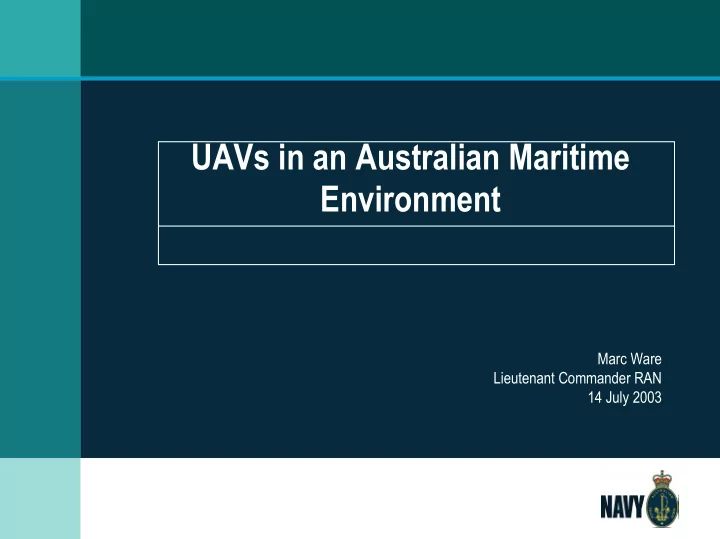

UAVs in an Australian Maritime Environment Marc Ware Lieutenant Commander RAN 14 July 2003
LCDR Marc Ware BSc BAvn MSc � 23 years service in the RAN � 2600 hours total flying experience � 1400 hours Seahawk experience � Capability Development experience � Flight Trials Officer at AMAFTU
Aim Remind the audience of my 2002 proposal for a Concept of operations for Maritime UAVs (MUAVs) in the Australian environment Update audience on achievements in this area since last year
Scope Capability Introduction Doctrine Gap Launch & Manpower Comms Recovery Command CONOPS Conclusion & Control
Scope Capability Introduction Doctrine Gap Launch & Manpower Comms Recovery Command CONOPS Conclusion & Control
Introduction � Concept of Operations that: � Satisfies a Capability Gap � Cost Effective � Fits into the current and planned RAN Force structure � Recognises the constraints of operating from sea: � Space � Personnel � Cost � Launch and Recovery � Augmentation of existing helicopter fleets
Scope Capability Introduction Doctrine Gap Launch & Manpower Comms Recovery Command CONOPS Conclusion & Control
Doctrine DCP Plan Blue White Maritime Paper Doctrine
Scope Capability Introduction Doctrine Gap Launch & Manpower Comms Recovery Command CONOPS Conclusion & Control
Capability Gap Probe & BDA MEZ ??? 5 - 20nm
Scope Capability Introduction Doctrine Gap Launch & Manpower Comms Recovery Command CONOPS Conclusion & Control
Manpower � Manpower is a significant cost driver � RAN will continue to operate current helicopters until 2025 � Most cost effective embarked UAV solution is to utilise existing aircrew
Scope Capability Introduction Doctrine Gap Launch & Manpower Comms Recovery Command CONOPS Conclusion & Control
Communications � Increasing requirement for satellite bandwidth � Alternative approach might be to only send snapshots of imagery � Improved Data Modem (IDM) offers a UHF alternative
Scope Capability Introduction Doctrine Gap Launch & Manpower Comms Recovery Command CONOPS Conclusion & Control
Launch & Recovery � Expense and complexity of autonomous landing systems � An alternative approach is to carry the UAV with the helicopter
Scope Capability Introduction Doctrine Gap Launch & Manpower Comms Recovery Command CONOPS Conclusion & Control
Command & Control � Technology already exists to command and control very small UAVs � Sensors can now provide useful imagery in packages no heavier than a few pounds. � Extendor program has proved that imagery transfer using standard UHF radios is possible using IDM. � Hunter Killer Stand-off Team program has proved the concept of teaming a helicopter with a UAV.
Scope Capability Introduction Doctrine Gap Launch & Manpower Comms Recovery Command CONOPS Conclusion & Control
Tiny Tiger Tiny Tiger
UAV (Medium Size - External Carriage) � UAV of Penguin Missile, Mk46 or MALD Size � Rejected � Cost � Provocative � Reduction in helicopter external carrying capacity
Deployment Canister 3 ft by 5 inches A size sonobuoy diameter Weight 39 lbs
UAV ( Small Size – Internal Carriage) � Pointer (9ft wingspan, 9 lb mtow, 1hr endurance) � Mite (1ft wingspan, 4 lb mtow, 0.5hr endurance) � Dragon Eye (4ft wingspan, 5 lb mtow, 1hr endurance)
Conceptual Design Battery driven propeller Material (similar to a hanglider) to save weight and space simplifies mechanics of fitting wing into a small container 3 ft Telescopic wing spars with t f 6 - 5 shaped aerofoil leading edge Aerial for GPS/Command & control data-link incorporated into a vertical stabiliser EO/IR sensor
Deployment Stages
MUAV in Free Flight
Concept of Operations Line of Deployment Sight Relay Second Stage Target Free Flight
Scope Capability Introduction Doctrine Gap Launch & Manpower Comms Recovery Command CONOPS Conclusion & Control
Conclusion � CONOPS proposes control of the UAV from the Maritime helicopter � Requires the design of a disposable MUAV packaged in an A size sonobuoy container � Makes maximum use of current personnel & equipment � No requirement for satellite links
Conclusion (2) � Small demand on ship space � Reduced complexity on launch & recovery � Reduces the risk to the crew while better complementing the existing helicopter fleet � Is technically feasible
International progress since 2002 � Number of flights of the Finder from a Predator UAV � HSKT have launched a vehicle from a 5 inch diameter tube
Local progress since 2002 � Codarra Advanced Systems - Avatar UAV � Aerosonde UAV
Local progress since 2002 � Sydney University
ADF Progress since 2002 � UAV Roadmap � JP129 OCD release � SEA4000 interest in UAV capability
Recommendations � Trial to test both control and imagery transfer between a Seahawk and UAV � DSTO and Industry develop a Tiny Tiger prototype, perhaps through a Concept Technology Demonstrator (CTD) Project � Consideration be given to a collaborative project
UAVs in an Australian Maritime Environment Marc Ware Lieutenant Commander RAN 14 July 2003
Recommend
More recommend